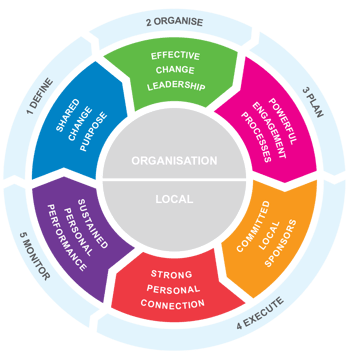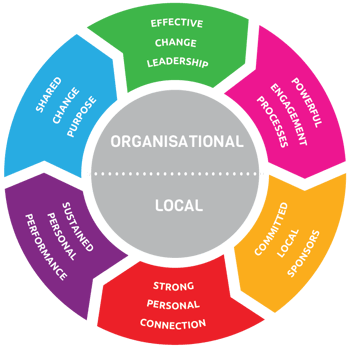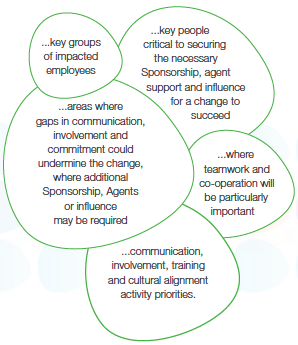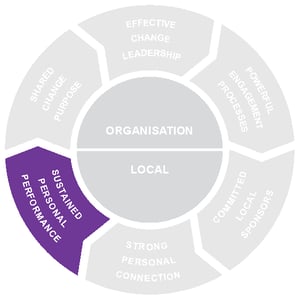- The leadership challenge
- Barriers to lasting change
- Fresh approach to change
- Managing capacity and demand
- Benefits of a flexible methodology
- Learning from the past, planning for the future
- 6 Critical Success Factors
- Conclusion
The leadership challenge
Leaders must be able to transform their organisations regularly to deliver long-term competitive advantage, in an environment where organisational change is becoming more frequent, complex and risky. Organisations must learn new ways to implement change initiatives and sustain them long enough to realise the benefits.
Demand for deep, sustainable change in organisations is being driven hard by forces coming from all directions. Radical disruptions to competition, regulation, technology and customer expectations are creating an almost constant need for change. Shareholders are demanding more, from fewer resources. Empowered and innovative employees are mandated to find new ways to enhance profitability, business performance and competitive advantage – faster.
This new type of change is more difficult and complex. Business-critical global, regional and local change agendas are frequently overlapping, and often conflicting. Employees are becoming better educated and more questioning; they are much less receptive to autocratic, compliance driven leadership styles.
While transformational change is difficult, disruptive and expensive, organisations are often faced with no real choice when the alternatives – standing still or putting faith in a superficial ‘quick fix’ – are even riskier options. Clever strategies are not enough – successful organisations develop the internal capacity to implement change faster and more effectively than their competitors. Each change initiative must deliver the intended benefits and contribute to developing overall change capacity.
If corporate adaptability is to become embedded into the organisational culture, a prerequisite is that organisations successfully implement individual initiatives. Yet research consistently reveals high failure rates for transformational change initiatives:
- According to Business Intelligence seven out of ten change efforts that are critical to organisational success, fail to achieve their intended results.
- Independent IT research firm Gartner Group reports that for major corporate systems investments:
- 28% are abandoned before completion
- 46% are behind schedule or over budget
- 80% are not used in the way they were intended to be or not used at all six months after installation.
Many so-called failures are actually change projects that have been partially installed, rather than fully implemented. The organisational, strategy, process and technology components of a change initiative may have been put in place effectively, but are not being applied or used in the intended way with the required level of understanding, commitment and personal ownership. People readily slip back into their old ways of working when change leadership efforts are prematurely withdrawn.
Executives report familiar problems:
- Changes take too long to deliver their intended benefits, they only release benefits in limited areas, or they are never completed.
- People, who are often already overwhelmed with their workload, become more cynical about the likelihood of any new changes being successful, particularly if there is a legacy of poorly implemented change.
- It is increasingly difficult to build sustained employee commitment to new changes.
- Organisations become unable to deliver their core strategies owing to high levels of resistance.
- Limited genuine individual and organisational learning takes place, leading to over-reliance on external expert support and loss of control over business critical changes.
- Leaders’ credibility is undermined as they ‘over-promise and underdeliver’ through a lack of realism, discipline and competency, around the challenges of implementing major change.
True implementation goes beyond mere installation – it requires that a critical mass of people are committed, are willing to change and will sustain their new behaviour to align with the needs of the change. Effective change management is the critical bridge between partial installation and full implementation and is essential to the delivery of sustained benefit.

Barriers to lasting change
Change is deeply personal. Organisations implementing change frequently underestimate the extent, timescale and complexity of the leadership and management involvement required to overcome resistance and build commitment.
Research by the Gartner Group has confirmed that the number-one reason for change initiatives to fail is the inability of people to adjust their behaviour, skills and commitment to the new requirements. Uncertain, anxious, overwhelmed, untrained and confused people, who feel out of control and don’t know what to expect, do not perform well.
The same problems are encountered again and again…
Weak leadership
Poor understanding, execution and coordination of the roles Change Leaders need to play (Sponsors, Agents and Influencers) undermine implementation. Initiatives often stall, for example, when there is a mismatch between a Sponsor’s words and actions or if confidence in the Change Agent is low. Failure to leverage powerful informal influence from other key people can also undermine implementation. All leaders need to act as role models, tackling resistance, creating readiness to change and building commitment at every level of the organisation on a daily basis.
Inability to deal with resistance
The greater the disruption and personal impact of the change, the higher the level of resistance. Employees may oppose a move away from the status quo if they fear that change will have a detrimental effect on their security, personal finance, working relationships or level of responsibility – or simply because they do not have enough time to learn properly about the change. Change is a deeply personal experience: leaders and Change Agents need to respond effectively and sensitively to employees’ personal concerns and reactions to the change, in order to secure lasting commitment.
Cultural misalignment
Transformational change initiatives often challenge people’s deeply held values about the way they work, how they are supervised and how they are rewarded. Beliefs around how the organisation is performing, its role in the marketplace and what makes it successful are also fundamentally questioned. Conflicts or inconsistencies with the organisational culture, which are inherent in the change, create barriers to lasting change. Five key areas are a potential source of conflict – or support – for change: organisational practices, leadership style, management practices, HR policies and performance management. The organisational culture must be aligned with the new change agenda from the outset, to help people change their behaviour, engage with and sustain the change.
Too much concurrent change
Organisations often struggle with change due to the sheer number of initiatives they are trying to implement. Failure to anticipate, measure, monitor and manage change demand and the available organisational ‘human capacity’ to implement change, increases failure rates. Given that change capacity is finite in the short term, if leaders fail to control the portfolio of overlapping changes and set clear priorities, scarce human resources can be tied up in lower priority projects, leaving the organisation unable to respond quickly and effectively to unanticipated business change imperatives.
Poor change management process methodology
Without a consistent and effective change management process methodology organisations are unable to guide priorities, decision making and performance management. Lack of a common language, inconsistent approaches and limited measurement and tracking have a detrimental effect on individual change initiatives, but can also impact overall organisational change capacity in the long term because learning and experience are not easily shared. Certain inappropriate behaviours, for example, crop-up repeatedly, undermining an organisation’s confidence in its ability to implement new initiatives. High levels of cynicism arise which are then difficult to dispel. (See ‘Learning from the past, planning for the future’).
In our view the role of the Change Agent is a mixture of dynamics which incorporate practical thinking and softer skills like coaching, mentoring and convincing.
| Change Roles & Responsibilities |
| Sponsors are ultimately accountable for the successful delivery of benefits from the change in their area. From the Adapters’ perspective they have the organisational power to legitimise change, reward commitment and provide consequences for not changing. |
| Change Agents work in tandem with Sponsors and are responsible for the planning and execution of activities that enable people to adapt to and implement the change. |
| Influencers have low organisational power and cannot approve or veto the change, but they have significant influence over others and can help to build a critical mass of support by delivering positive, encouraging and supportive informal messages. |
| Adapters have to adapt to new ways of working and must change their behaviour, values and skills for the change to succeed – everyone is viewed initially as an Adapter. |
Fresh approach to change
For organisations to realise the full benefits from change, they must focus on managing people’s behaviour, skills and commitment to deliver successful implementation – and that must be led by people inside the organisation.
Major change only takes place when people shift their values, aspirations, skills and behaviours. When people stay in a particular situation for a period of time they usually develop established ways of thinking, feeling and behaving which are disrupted by the onslaught of major change.
Effective change management provides the process, tools and techniques to manage the people aspect of change – to achieve the most successful business outcome. It overcomes resistance and builds the necessary commitment in people that enables them to be ready, willing and able to change.
To manage employees’ transition from resistance to commitment, the change needs to be internally led. Employees require lots of information, training, support, involvement and appropriate rewards, to feel valued, more in control of their destiny and committed enough to engage fully with change.

Managing capacity and demand
A major reason changes fail in organisations is that people feel overwhelmed by the sheer volume and speed of change initiatives impacting them.
This often leaves them stressed, but at a minimum leaves them with little capacity to digest key organisational initiatives. If an organisation is to manage change effectively it must ensure that people have sufficient change capacity to be able to implement the really critical strategic changes.
Change capacity is a combination of people-based factors that affect the organisation’s ability to adapt. These include such building blocks as change legacy, implementation capability, personal adaptability levels and change leadership style. The greater the capacity to change, the more able the organisation will be to implement transformational change and/or to simultaneously implement multiple change initiatives.
Leaders must rigorously manage total change demand – measuring, understanding and controlling the number, speed and complexity of all changes in the pipeline. They must also evaluate the extent to which people are coping with the current change demands being placed on them.
To implement a portfolio of major changes successfully, leaders need to monitor and manage all three risk components: the overall demand for change, the organisation’s capacity to implement that change and the specific risks of an individual change initiative within that context.
A balanced relationship which stretches the organisation without overwhelming the finite capacity for change is critical to overall implementation success.
If the business operates with demand exceeding capacity for long periods people will become overwhelmed – stress levels will undermine morale, productivity and quality, overall capacity will actually decrease and leadership credibility will be questioned.

Benefits of a flexible methodology
Planning and executing the people and organisational aspects of change initiatives with a flexible methodology helps to guide priorities, decision making and performance management.
When faced with business-critical change projects with a high cost and/ or risk of failure, organisations often rely heavily on external consultancy support. However, implementation of this type of change is only possible if the initiative is visibly led by people inside the organisation. As the scale, frequency and importance of change increases, internal leadership and control become critical for corporate adaptability.
Employing a comprehensive, disciplined and systematic approach can significantly improve success rates. The methodology helps to maximise learning, build internal capability and increase overall organisational capacity while delivering the benefits from individual changes. This clear framework allows organisations to analyse and anticipate risks and enablers, while providing a motivating sense of control, clarity and belief that change is being effectively managed. It creates a common language and mutual understanding which enhances individual, team and organisational learning and knowledge transfer.
Aligning with other business processes allows for more integrated change planning. Using an effective change management process methodology, with supporting assessment and monitoring tools and integrated processes, enables leaders to:
Evaluate the relative difficulty of changes in their portfolio and allocate resources accordingly, setting more realistic targets, schedules and budgets.
Understand people’s issues, their capacity for change and their reactions to the change with the same clarity that one might expect to understand technical, logistical or financial issues.
Make reality-based decisions using leading-edge measures – avoiding reliance on gut feelings, subjective feedback, conventional wisdom and myth that often lead to decisions which focus on the wrong change performance drivers.
Measure change implementation progress in all areas of the organisation and understand where, when and how change efforts are working, where corrective action is required and on which areas to focus limited change management resources.
Predict risk early using structured predictive change assessments – managing the issues likely to arise on a more proactive basis, rather than continually fighting fires.
Instill a common language and mutual understanding which enhances individual, team and organisational learning and knowledge transfer.
The 6 Critical Success Factor Model with Change and Project Management Integration

Learning from the past
An organisation’s performance in previous change initiatives reveals a wealth of predictive knowledge and learning about their ability to manage change and provides a road map for modifying future efforts.
Organisations tend to have a ‘way of doing change’, irrespective of the nature of the change. They unconsciously repeat the same old mistakes and use the same techniques that have fallen short in the past. Strong, deliberate and visible action must be taken to radically change this approach.
Changefirst® has developed the Initiative Legacy Assessment tool to enable organisations to benchmark their change performance. This tool collects historical data from people at different levels in the organisation to:
- measure the effectiveness of previous change implementation with respect to the 6 Critical Success Factors, benchmarked against the database norms;
- predict likely levels of commitment/resistance and potential barriers to successful implementation of future initiatives;
- help facilitate mitigating action planning for a particular initiative.

6 Critical Success Factors
To deliver the desired business objectives of change, employees must be ready, willing and able to change their behaviour. Understanding the key drivers allows Change Leaders to quantify and track the progress of change actions and take either reinforcing or corrective action.
Changefirst® has identified 20 risk factors which can be mapped to 6 Critical Success Factors (CSFs) that must be in place for successful change implementation (see diagram). These factors have been translated into a robust process which covers the key areas of implementation that Change Leaders need to excel at, in order to develop the critical mass of commitment required to succeed.
While the logical starting point is establishing shared change purpose, the model does not have to be applied strictly sequentially; activities overlap and are revisited as appropriate to the dynamics of the change as they unfold.
Understanding these factors helps Change Leaders to ensure both that the organisational requirements for change are in place and that the local needs during change are managed effectively. Managing the balance is an ongoing, dynamic process: too much focus on organisational factors often leads to compliance, too much focus on local factors frequently leads to inconsistent application. The Changefirst® methodology, People-Centred Implementation (PCI®), is designed to support a high, yet appropriate, level of involvement of those affected by the change at the organisational and local levels of the company.
The 6 Critical Success Factors:

Critical Success Factor 1
Shared Change Purpose
Articulating, communicating and maintaining a shared purpose helps create urgency, energy and unity. It is the critical first step at the launch of an initiative, but also directs people’s focus and maintains their resolve and motivation as they work towards achieving and sustaining the change benefits.
The shared purpose, comprising a clear imperative (the reason people cannot stay at the status quo), vision for change and the proposed solution, needs to demonstrate that the team leading the change effort share ‘one voice’ about the change. For Local Managers, who will be called upon to reinforce the change in their parts of the organisation, a shared purpose demonstrates that there is clarity of direction and that it is owned by the leadership of the organisation.
This clear statement of intent and purpose is necessary for building commitment and reducing the confusion that often generates demand for unnecessary change. It helps people to deal with some of the personal disruption they need to overcome before embracing the change:
- People gain a sense of control, because they have a realistic picture of what to expect when the change is successful.
- People feel a sense of confidence that there is commitment to provide the necessary support from the highest levels in the organisation.
- People develop a sense of comfort that their involvement will enable them to directly influence what happens to them during major change.
CSF1 Action Agenda
The challenge for Change Leaders is to articulate and communicate a powerful statement that encompasses the imperative, vision and solution. It must:
- provide people with a strong sense of purpose and opportunity
- allow delegated decision making
- give people the freedom to act
- establish expectations for individuals.
Without this urgency, resolve and energy, particularly at the start, major changes can become stalled or fail to gain traction in the organisation. A shared purpose also helps people sustain their energy through the difficult transition state. It gives them the resolve to continue moving forward, rather than go back to the feelings of comfort and control of the current state.
The more key people that share the change purpose, early in the initiative implementation, the better. Certainly Change Leaders and Key Influencers in the organisation need to share it, believe in it and, ideally, have played a role in creating it.
Critical Success Factor 2
Effective Change Leadership
People are more likely to understand and energetically support an initiative when they observe leadership behaviour that is both credible and supportive. Typically, assessing and developing the effectiveness of Change Leaders should be tackled once the shared purpose and intent of the change have been sufficiently defined
Effective, early leadership from Sponsors and Change Agents is critical to signalling clear intent, building momentum, raising credibility and overcoming initial resistance before early results are visibly achieved.
When change leadership is strong, people can move more quickly from understanding to support for the initiative. When change leadership and influence are weak, people may not believe the change is worth supporting or investing energy in. They become more likely to focus efforts on maintaining the status quo rather than moving forward. This is particularly true if there is a legacy of poorly implemented change, which has undermined credibility in the change leadership of the organisation.
The personal impact and cost of change increases when personal implementation issues become clarified. Early commitment may be undermined and resistance re-emerge as employees progress through the change. Leaders must continue to role model behaviour and take early corrective action to address pockets of resistance and weak commitment.
Leaders can declare victory too early and refocus their energies on other priorities. This may allow employees, at all levels, to slip back into old patterns of behaviour.
CSF2 Action Agenda
Change leadership roles must be clearly defined, with the right people appointed and developed early in the process to fulfil their responsibilities in an informed, committed, collaborative and enthusiastic manner.
Leaders also need to develop and maintain a comprehensive organisational change network map to develop a common and realistic understanding of the real power and influence impacting change effort. It helps ensure impacted employees receive the right level of timely, visible support and encouragement from leadership at all levels.
Leaders must take visible action to demonstrate their genuine commitment to the change imperative and future state; for example, role modelling desired behaviour, providing private and public support, encouraging the sharing of honest views. Probably most importantly, they must start to use the change in their own work. People are more likely to understand and energetically support an initiative when they observe leadership behaviour that is both credible and supportive. Typically, assessing and developing the effectiveness of Change Leaders should be tackled once the shared purpose and intent of the change have been sufficiently defined.
Change Network Map
A comprehensive Change Network Map depicts the true political network of real power and influence driving the organisation. It helps to identify…

Critical Success Factor 3
Powerful Engagement Processes
Powerful Engagement Processes to overcome resistance and build commitment must be implemented, improved and sustained until the benefits of the change have been realised and new behaviours are firmly embedded in the culture.
Planned formal approaches need to be developed which bring people and the change together in a purposeful way to help them deal with their doubts, build their will to succeed and encourage them to adopt new behaviours. Powerful Engagement Processes provide ways for people to connect with the change effectively.
There are five key organisational processes that help people break away from the past and provide support for the new ways of working.
Sponsors and Agents must:
- involve people meaningfully in the change, giving them a sense of control, and manage their available capacity
- provide supportive education and training opportunities to develop knowledge and build competence to behave in the new ways
- reward people for engaging with the change and behaving in new ways
- ensure that two-way communication takes place, which clarifies and makes practical what is happening.
- Lastly, make sure that the organisational alignment mechanisms support the change and sustain the initiative. If necessary, for example, change the way people are selected and promoted to support the new skill and behaviour requirements
CSF3 Action Agenda
It is critical that the Change Agents, working with specialists, design engagement processes that help people build the desire and skills to use and own the change. If this doesn’t happen, it’s very probable that the change will be ignored by the people impacted or organisations will get a type of ‘minimal compliance’. This is where people do the minimum necessary to avoid censure but rarely engage with the intent or spirit of the change.
Critical Success Factor 4
 Committed Local Sponsors
Committed Local Sponsors
Strong change leadership from Sponsors at the local level ensures that change is implemented effectively throughout the organisation.
Changes often fail when a gap emerges between a Sponsor’s announcements and subsequent local actions. Research has repeatedly shown that employees pay most attention to the messages from their immediate boss and often disregard much of what conflicts with it. To maximise the effectiveness of the change process, Committed Local Sponsors need to take personal responsibility for change in their areas. Without strong local Sponsorship the change will not be implemented by employees and/or strong resistance will quickly emerge and not be addressed.
The role of the local Sponsor is critical in connecting the work done at the organisational level to the reality that people have to change at the local level in order for the initiative to be successful. If Local Sponsors are bypassed and not enlisted by organisational level Sponsors, the result will be installation, at best, rather than implementation.
Local Sponsors should be:
- actively involved and provide hands-on leadership
- communicating, via their actions, their total commitment to driving the project forward
- accountable for the complete and timely implementation of the change in their area.
CSF4 Action Agenda
Change Leaders must build a network from the top down, ensuring strong personal connection, readiness and commitment in Sponsors before cascading to the next level. Local Sponsors cannot begin to fulfil their role until their own personal needs and concerns about the change are addressed. They need to have sufficient commitment to the change so that they can express that commitment to employees and other key players on their own.
Responsibilities must be delegated to Local Sponsors who combine authority and credibility with employees who are impacted by a specific change initiative. Committed Local Sponsors must translate the organisational change purpose into something that is more tangible and personal for Adapters, addressing the issues that might prevent or inhibit strong personal ownership by Adapters.
Critical Success Factor 5
Strong Personal Connection
A Strong Personal Connection exists when individuals affected by the change recognise that they personally cannot continue to work in the current way, believe the solution is acceptable and understand how they can be successful in the future.
Commitment to the change needs to be built and maintained by local Sponsors. At a minimum people need to use the change, even if they are not yet deeply committed to it. Ideally – and in some changes, essentially – organisations need people to own the change, that is take personal responsibility for those aspects of the change which they can control or impact.
The creation of strong personal connection is critical to successful implementation of major change. It provides:
- a platform upon which commitment to the change can be accelerated
- a means for initial engagement so that people can understand the need for change, giving people the essential prerequisite information and time to adjust before they start to be actively engaged and involved
- the chance for people to see personal ‘opportunity’ in the change, reducing the intensity of natural resistance
- a reduction in the probability of people being ‘detached’ from the change and staying in ‘denial’.
CSF5 Action Agenda
Local Sponsors must be encouraged and educated in how to work with Adapters at all levels to help them become connected to the change. They need to work with individuals in local groups to establish their personal connection to the change and translate words into actions – continuing to role model the change. Sponsors should analyse who stands to lose out and pay them special attention. They should ask people to explain what change means to them and encourage people to consider how the change will affect them personally.
Most people develop a personal connection to a change through involvement – they need face-to-face contact and the opportunity to debate, discuss and argue to build personal levels of readiness to change.
Sponsors and Agents should:
- describe change in as much detail as possible
- highlight the local area’s contribution or connection to the vision, imperative and solution
- identify early actions that can be accomplished to move the change forward
- work with employees to develop ‘A day in the life of’ stories to create a picture of what success looks like in the future
- find ways for people to test the new way of working without any negative consequences if they make mistakes
- use actions more than words, to demonstrate what the change means.
Critical Success Factor 6
 Sustained Personal Performance
Sustained Personal Performance
Change initiatives only become implemented when Change Leaders throughout the organisation pay careful attention to how Adapters are reacting to the change.
Many changes fail, even though brilliantly orchestrated, because people still have concerns, such as: they will be negatively impacted financially or positive work relationships become fractured. Sponsors, working with Agents, need to identify these impacts and where possible work to eradicate or lessen them.
Failure to pay constant attention to managing personal issues, before the change is fully anchored in the workplace, can result in lost momentum or erosion of the change. If personal issues of committed individuals are ignored and their commitment is lost, the negative impact of a key change supporter withdrawing support either openly or covertly will be highly damaging to the change effort.
CSF6 Action Agenda
The ability to develop individuals who have sufficient ownership of the change, to sustain personal performance, will depend on the Change Leaders’ ability to identify those key people at the start of the process and adopt a supportive, commitment-building approach.
When a positive personal performance towards the change is observed it must not be taken for granted that it will be sustained. Agents must manage the personal/individual resistance to change that can emerge to jeopardise sustained personal performance towards the change.
Change Leaders need to respond effectively to the personal concerns and reactions of people to the change, in order to maintain their sustained personal performance.
A network of Sponsors and Change Agents must:
- monitor for sustained personal performance
- identify behaviour that indicates a regression of commitment or resistance to the change
- discuss these behaviours effectively and address issues that may be barriers to sustained personal performance
- employ tactics to deal effectively with personal issues around future security, financial impact, work relationships, levels of responsibility and learning curves.
Conclusion
Change is changing: it is becoming more frequent, radical and complex. Failure rates are high because organisations install new systems, processes or practices, but fail to implement the change fully – people are not sufficiently committed to the new ways of working.
Change is not an ‘event’, but a dynamic process that unfolds over time. The fundamental challenge that leaders are facing is how to transform the business through major change initiatives, with minimum disruption, using mainly internal resources, at a time when they are more vulnerable to external competitive threats and internal disruption.
The sheer complexity of change today requires a more disciplined, informed, competent and structured approach, underpinned by a highly-committed, visible and determined leadership, to support people through the disruptions and uncertainty of change. Quick fixes, while tempting, don’t deliver sustained change. A deeper, systematic, consistent and integrated approach is required now – it is becoming an essential core competency of successful organisations.

 Committed Local Sponsors
Committed Local Sponsors Sustained Personal Performance
Sustained Personal Performance

